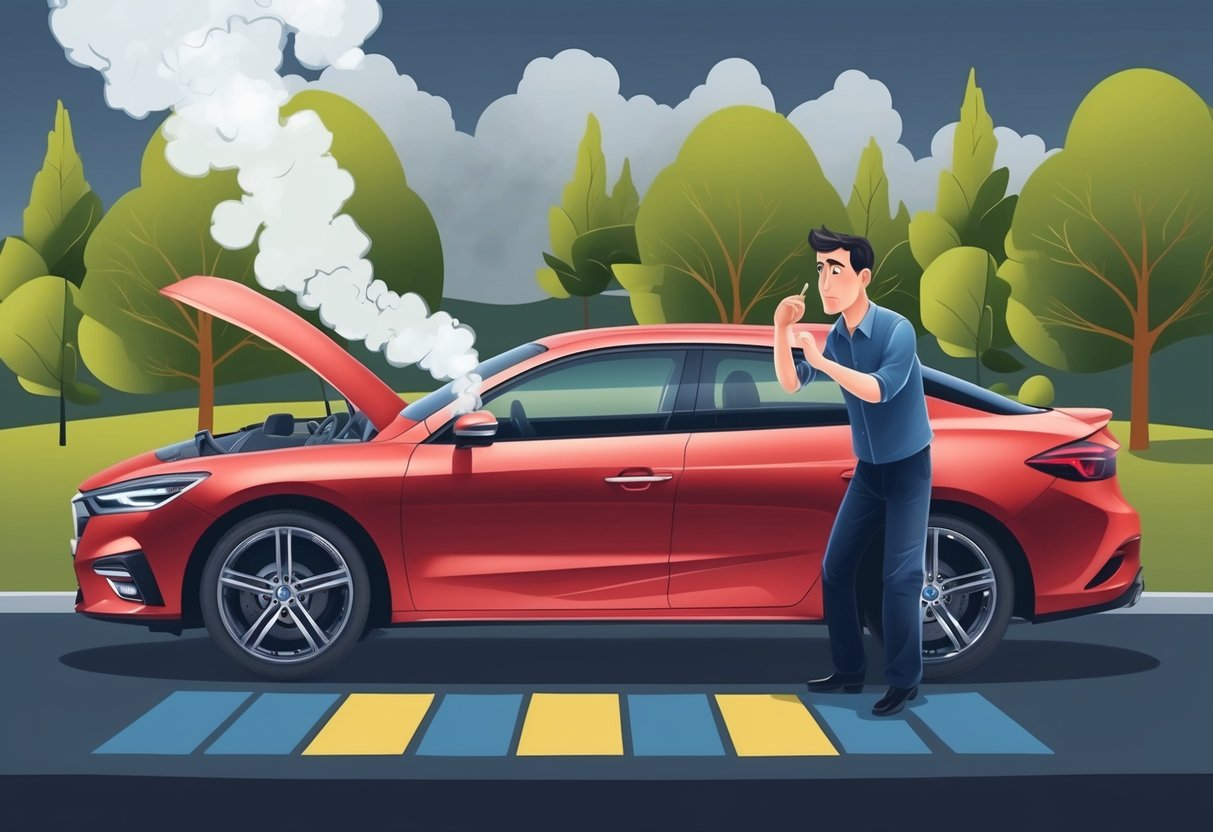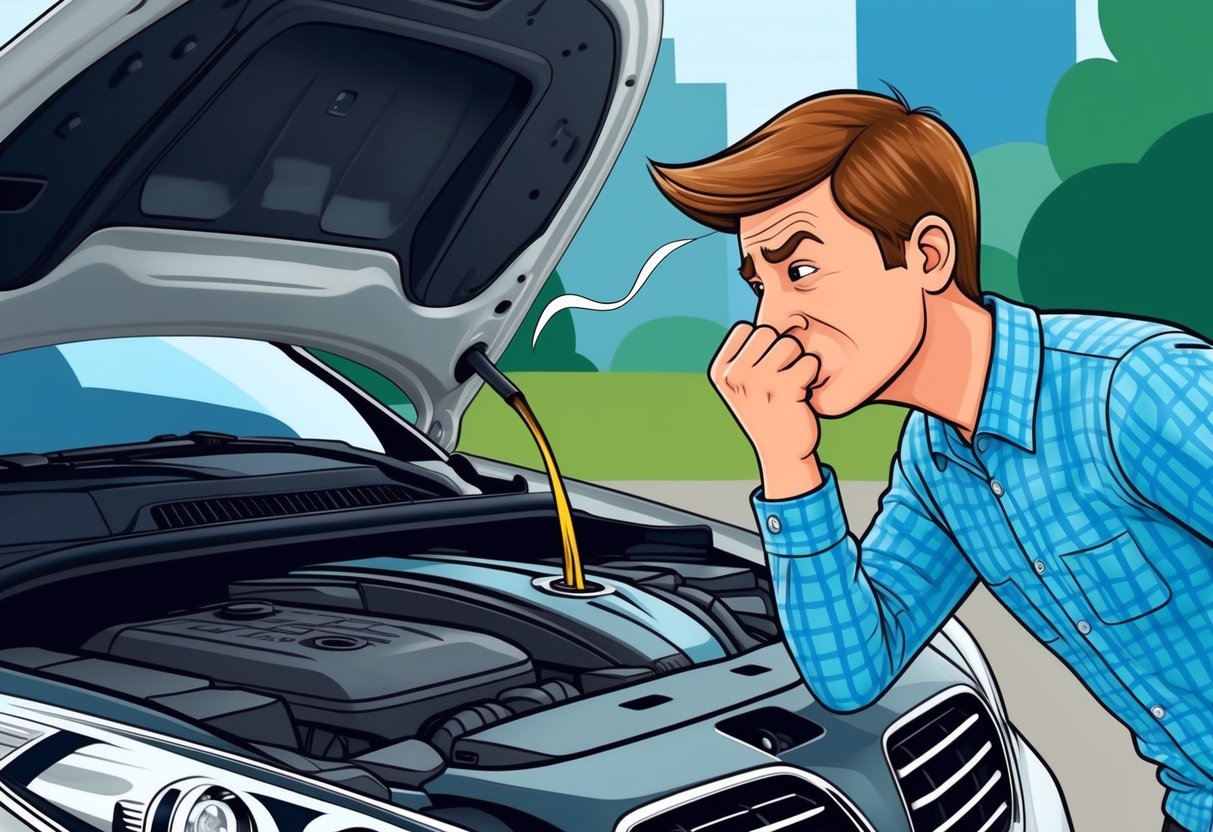
Odor and Visual Inspections

Transmission problems often produce clear signs that can be detected with basic odor and visual checks.
Paying close attention to how the transmission fluid smells and spotting leaks on the driveway can help catch issues before they escalate.
Identifying Burnt Smells
A strong, burnt odor coming from under the hood or beneath the vehicle often signals transmission trouble.
This smell is usually caused by overheating transmission fluid, which can lose its ability to lubricate and protect the transmission’s parts.
Drivers should check the transmission fluid level and color regularly. Healthy fluid is typically bright red and nearly odorless, while burnt or dirty fluid turns brown or dark and carries a sharp, acrid smell.
If the smell is detected during an oil change or routine maintenance, the car should be inspected by a technician. Ignoring these symptoms can lead to more extensive internal damage and expensive repairs.
Inspecting Fluid on the Driveway
Spots or puddles under the vehicle can indicate a leaking transmission.
Unlike other automotive fluids, transmission fluid is generally red or pink, although it may turn brown if it’s old or burnt.
Visual leaks suggest seals, gaskets, or transmission pan issues. Noticing fluid on the driveway after the car has been parked should not be ignored, as driving with low or contaminated fluid can cause severe gearbox problems.
Leak locations may align directly beneath the engine bay or slightly towards the center, depending on the transmission design. Timely identification and repair of leaks prevent further deterioration and can extend the lifespan of the transmission.
A simple inspection routine includes:
- Checking under the vehicle for fresh fluid spots.
- Using a white paper towel or cloth to identify the fluid color.
- Monitoring fluid levels with the dipstick, if accessible.
If leaks persist, a professional should assess the transmission system for hidden problems. For more information about the importance of these inspections and warning signs, visit this guide to transmission repair signs.
What To Do If You Suspect Transmission Failure
When a car shows signs of transmission problems, ignoring them can quickly lead to more severe damage and expensive repairs.
Staying alert and knowing what actions to take right away can prevent further issues and ensure your safety while getting the necessary transmission repair.
Immediate Steps to Take
If warning signs appear, such as slipping gears, refusal to switch gears, unusual noises, or a burning smell, stop driving as soon as you safely can.
Continuing to drive with a failing transmission often makes the problem worse.
Once stopped, check the transmission fluid level if possible. Low or dirty fluid is a common cause of transmission malfunction.
Park the car on a flat surface, engage the parking brake, and use the dipstick to inspect the fluid level and color. Transmission fluid should be reddish and translucent—not dark or smelling burnt.
List of immediate actions:
- Shift to park and turn off the engine.
- Inspect under the car for any leaks or puddles.
- Avoid revving the engine.
- Document any dashboard warning lights or odd sounds.
- Do not attempt home repairs unless you have experience.
If the problem is obvious and simple—such as low fluid—topping it off according to the owner’s manual may be a temporary solution. Seek professional help promptly for further diagnosis and repair.
For more details on common warning signs, visit this guide on transmission failure symptoms.
Safely Getting Your Car to a Mechanic
If transmission failure symptoms are present, it is safest to tow the car to a repair shop instead of driving it.
Driving with a failing transmission can cause total breakdown or further mechanical damage.
Contact a towing service and inform them about the suspected transmission issue so they can use appropriate equipment. If you must drive to the shop in an emergency, shift gently, avoid sudden acceleration, and select the lowest gear possible to reduce strain on the transmission.
Only do this for very short distances if absolutely necessary. Before transporting the car, gather any notes about symptoms, warning lights, or dashboard indicators to share with the mechanic.
Schedule an inspection or diagnostic test as soon as possible, as early intervention can make transmission repair easier and less costly.
For more information on getting professional help, refer to these essential transmission problem tips.
Professional Transmission Diagnosis and Repair
Early signs like fluid leaks, shifting problems, or unusual noises indicate a transmission may be failing.
Timely intervention can prevent the need for a full transmission rebuild and help avoid costly long-term damage.
When to Seek Expert Help
Car owners should look for persistent issues such as difficulty shifting gears, unexplained vibrations, a burning smell, or visible transmission fluid leaks.
These warning signs often point to underlying transmission repair needs and should not be ignored.
If the transmission warning light appears on the dashboard or if there is hesitation and clunking during gear changes, immediate inspection is advised. Unusual sounds like humming, clunking, or grinding can mean a worn clutch, low fluid, or damaged components.
If any of these symptoms persist after topping up or changing fluids, a certified transmission specialist should inspect the system.
For more details on common warning signs, visit this overview of transmission problems and how to diagnose them.
Expected Repair Costs
Transmission repair costs vary based on extent of the issue and car make and model.
For minor problems such as replacing transmission fluid, a typical shop charges between $80 and $250.
More significant repairs like solenoid or sensor replacement can cost $300–$900. A full transmission rebuild or replacement may range from $1,000 to over $4,000, depending on labor and parts.
Complex issues often raise costs, especially with vehicles requiring specialized parts. Comparing quotes from certified repair shops and understanding warranty coverage can help reduce unexpected expenses.
For a breakdown of common repair scenarios, see this guide to transmission issues and repair strategies.